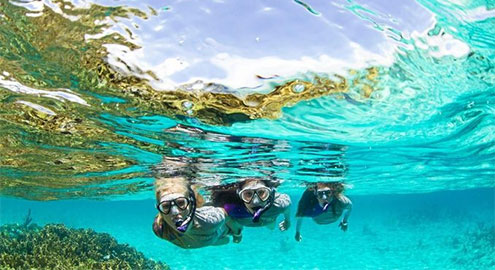Snorkelling Limits and Safety Precautions

Knowing your limits and not exceeding them is excellent advice for 99.9% of activities in which a person participates. Snorkelling is not an exception. Going beyond your physical limits can turn an otherwise enjoyable adventure into an uncomfortable and potentially hazardous situation. The following are some guidelines and safety precautions that should be followed when engaging in snorkelling.
- Don't go in the water if you are tired or following any strenuous activities as it requires energy and stamina and could actually be considered a form of exercise in and of itself.
- Proper gear at minimum includes a mask, fins and snorkel. The mask should fit comfortably and enclose the nose. The fins should have some flexibility to the blade portion and follow manufacturer recommendations whether additional foot gear such as boots are needed when using them. Snorkels should have the appropriate bore size.
- Don't use any equipment that is damaged. Mask and fin straps, belts, keepers, buckles etc. should be inspected for any wear and tear prior to use and replaced if needed. A spare parts kit with appropriate replacement parts is always good to have on hand.
- It is not advisable to go in the water alone and much more enjoyable and safer with a snorkelling buddy.
- Children using snorkel gear should be supervised by adults at all times.
- Learn about your intended snorkelling site. If you are at a resort, check with the front desk or concierge on where to obtain information on local sites. Many resorts have onsite water activity coordinators or are associated with facilities which offer fee based boat tours. These, as well as local area dive stores, are your best resources for finding areas that offer good opportunities. Formal orientations should include information such as local marine life, special information regarding safety and even interesting history about the sites themselves. If your adventure is shore based, make sure that you take into account the water conditions including current, surf, wave action and tide, check the weather forecast. For information about snorkelling here in Melbourne, please see Snorkelling in Melbourne and Melbourne Snorkelling Sites.
- Exposure protection is always advisable both in and out of the water. T-shirts, sunglasses with polarised lenses and a hats are good for out of the water. In water exposure protection is also advised as heat loss in water is more rapid than on land so choosing exposure protection which offers some thermal insulation such as a neoprene shorty or jumpsuit is also a good idea. These suits will not only slow down the heat loss but will also add a measure of protection against sunburn and accidental contact with marine life such as corals and jellyfish.
- If you are incorporating hunting, harvesting or collecting any marine life, please obtain any necessary permits and be mindful of the laws and seasons for such activity.
- Be aware of marine life. Assuming marine life such as dolphins will act as they do in the movies is a big mistake. There is a big difference between trained animals and wild animals. Avoid wearing reflective jewelry such as rings and dangling pendants as they are better used as fishing lures.
See also, Snorkel safety: a guide for workers - Worksafe QLD, plus our guide on How to Enter and Exit the Water.
Our Favourite Snorkelling Safety Items
 Tusa Sport Reef Tourer Snorkelling Vest - Youth
Tusa Sport Reef Tourer Snorkelling Vest - Youth
RRP: $75, Our Price: $67, You Save $8 (11%).
This vest provides you with enough Buoyancy, Safety and Comfort for an extended day of Snorkelling without fatigue. Ocean Hunter Inflatable Torpedo Float w Line & Alpha Flag (Ylw)
Ocean Hunter Inflatable Torpedo Float w Line & Alpha Flag (Ylw)
RRP: $49, Our Price: $46.50, You Save $2.50 (5%).
Increase your safety when snorkelling in areas with boat traffic by being seen more easily. IST Proline Duo-Chamber Split Fin Shaped Safety Whistle
IST Proline Duo-Chamber Split Fin Shaped Safety Whistle
RRP: $5, Our Price: $4, You Save $1 (20%).
Loud, shrill tone when blown makes it easy to attract attention when you need to.

